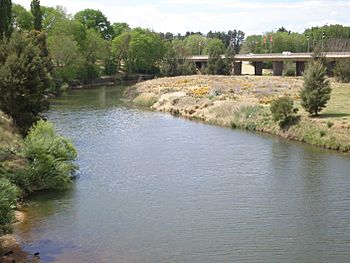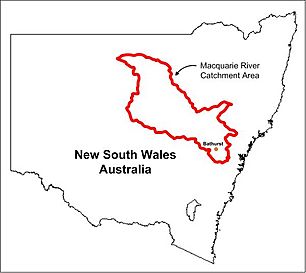Macquarie River facts for kids
Quick facts for kids Macquarie River |
|
|---|---|

Macquarie River at Bathurst
|
|
| Country | Australia |
| Physical characteristics | |
| River mouth | Barwon River |
| Length | 626 km |
The Macquarie River is one of the main inland rivers in New South Wales. It begins in the central highlands of New South Wales near the town of Oberon. The river flows northwest past the towns of Bathurst, Wellington, Dubbo, Narromine, and Warren to the Macquarie Marshes. The Macquarie Marshes then drain into the lower Barwon River and then into the Darling River
Burrendong Dam is a large dam (capacity 1,190,000 Megalitres) near Wellington which holds the waters of the Macquarie River and its tributaries the Cudgegong River and the Turon River to stop floods and provide water for irrigation. The dam made Lake Burrendong.
Contents
Geography
The Macquarie River flows for 626 kilometres and drops around 517 metres over its length. Lake Burrendong (346m) is the only dam on the river.
Tributaries
Six rivers flow into the Macquarie River:
- Fish River (670m)
- Turon River (406m)
- Cudgegong River (342m)
- Bell River (285m)
- Little River (271m)
- Talbragar River (257m)
There are 19 creeks that flow into the Macquarie River:
- Winburndale Rivulet (484m)
- Tambaroora Creek (398m)
- Pyramul Creek (360m)
- Curragurra Creek (351m)
- Triamble Creek (342m)
- Wuuluman Creek (302m)
- Wambangalong Creek (265m)
- Cumboogle Creek (263m)
- Mogriguy Creek (257m)
- Whylandra Creek (255m)
- Coolbaggie Creek (246m)
- Brummagen Creek (239m)
- Gin Gin Creek (217m)
- Greenhide Creek (209m)
- Bulla Bulla Creek (202m)
- Five Mile Cowal (187m)
- Marebone Break (184m)
- Bulgeraga Creek (179m)
- Oxley Break (171m). (descending elevation shown in brackets)
Towns along the river
- Bathurst
- Wellington
- Dubbo
- Narromine
- Warren
Bridge crossings
- Old Rail Bridge - Bathurst, is no longer used
- New Rail Bridge - Bathurst
- Evans Bridge - Bathurst
- Denison Bridge - Bathurst, (built 1869-1870) replaced a bridge was washed away by floods in 1867
- Rawsonville Bridge - Dubbo, is a Dare type timber truss bridge, and was completed in 1916
- Scabbing Flat Bridge - is a Dare type timber truss bridge, and was completed in 1911
- Dundullimal Rail Bridge
Watershed
The Macquarie system covers an area of more than 74,000 square kilometres. Over 72% of land is flat, and 17% is hilly. The rest is steep to mountainous, reaching 900 metres. The east boundary is formed by the Great Dividing Range, from near Oberon in the south to Coolah in the north. A mountain ridge goes north-west from the Great Dividing Range for about 400 kilometres, then the boundary turns north.
From Bathurst, near the start of the river it passes the following geographic areas:
- the Bathurst Plains, undulating country about 700 metres above sea level surrounded by high tablelands on all sides. This includes a large floodplain around Bathurst
- the Hill End Plateau where it is joined from the east by the Turon river. The Turon drains a plateau extending from near Portland to Sofala. This area is about 1100 metres above sea level in the south and 700 metres in the north. The area is mainly rugged mountain slopes
- Burrendong Dam, the Macquarie River is joined from the east by the Cudgegong River. This rises in the hills around Rylstone about 700 metres above sea level.
- through Wellington and Dubbo, the river is joined by the Bell and Little Rivers. The Bell River rises in flat to undulating country of the Orange plateau, about 900 metres above seal level. The highest point is the extinct volcanic peak of Mount Canobolas which 1,400 metres above sea level. Between Wellington and Dubbo large flat areas are evident.
- north of Dubbo, the Talbragar River joins the Macquarie. The Talbragar is the most important downstream tributary. This river rises in mountainous country at the junction of the Great Dividing Range and the Warrumbungle Range. The country through which the Talbragar River flows is broad and flat, bordered by undulating hills that become smaller as the river nears Dubbo.
- north of Dubbo, the river passes through flat plains flowing north-west through Narromine and Warren. A complex series of creeks connecting the Macquarie, Darling and Bogan Rivers.
- Macquarie Marshes are at the end of the river channel proper. Near Carinda, the Macquarie is joined by the Marthaguy Creek which drains an area 6,500 square kilometres and carries flood water from the Macquarie and Castlereagh Rivers.
Rainfall varies across the area drained by the Macquarie River. The mountain the peaks and tablelands receive higher rainfall due to the shadowing effects of the surrounding ranges. The Great Dividing Range area receives between 750 to 900 mm annual median rainfall. This is falls evenly throughout the year. Gaps in the Dividing Range allows moist easterly air to pass inland, annual median rainfall of 750 mm or more is experienced further westward. Further north-west it is drier, in the Castelreagh and middle portions of the Macquarie valleys the annual median rainfall is 300 to 400 mm.
Rainfall can vary dramatically over several years. Records show that rainfall can be 200% or less than 50% of the average annual figure. Evaporation varies from less than 1000 mm south-east of Bathurst up to more than 2000 mm at Bourke.
Statistics
| Area Total | 12,300 km² |
| Total storage volume | 1,559,620 ML |
| Total surface water use | 406,840 ML/yr |
| Development Category | over developed |
| Mean annual run-off | 0 ML/yr |
Aboriginal history
The Wiradjuri people are the original people to live in the Macquarie River area. The Wiradjuri called the river Wambool. The famous Wiradjuri warrior Windradyne came from the upper Macquarie River region. He was killed in a tribal battle alongside the river in 1829.
Near Carinda between the Macquarie River and Marra Creek, the oldest evidence of bread making in the world (about 30,000 years old) was found at an ancient lake known as Cuddie Springs.
European history
The upper parts of the Macquarie River were first seen by Europeans in 1813. The river was named for the Governor of New South Wales, Lachlan Macquarie. In 1813 surveyor George Evans wrote in his journal:
Tuesday, 30th November 1813. I have at length reached the Ridge I so much wished to do after walking about 2 Miles, where I had a prospect to the North for a great distance; A Mist arises from a part I suppose to be a River or a large Lagoon about 20 Miles Off;
Thursday, 9th December 1813. I have called the Main Stream "Macquarie River".
In 1817-18 John Oxley followed the Lachlan and Macquarie Rivers. In 1828 Charles Sturt proved that Macquarie River ended in marshes. He discovered the Darling River
Irrigation
The Macquarie River area is a regulated Water Management Area and includes private irrigation as well as several public irrigation schemes
- Narromine - Trangie
- Buddha Lakes
- Tenandra
- Trangie – Nevertire
- Nevertire
- Marthaguy
Flooding
The Macquarie River has a history of flooding. After major floods water can flow past the Macquarie Marshes and into the Barwon-Darling river system upstream of Brewarrina.
Floods
- 1867, floods washed away the first Denison Bridge at Bathurst
- 1955, serious flooding of Macquarie River amongst other river systems
- 1998, there was a large flood that affected the farming of cotton and vegetables.
- 2010 November/December saw major flooding of the lower Macquarie River following heavy rainfall events throughout Eastern Australia
Recreation
Recreational activities are popular along the length of the river particularly in the communities it passes by.
- Fishing - The following species of fresh water fish can be caught; brown trout, carp, catfish, golden perch, murray cod, rainbow trout, redfin, silver perch, trout cod and yabbies.
- Lake Burrendong - a large dam very popular for water sports include skiing, jet skis, sailing, and general boating.
- Parks - in Bathurst along the bank of the river is Bi-Centennial Park, used for picnics, events, and bicycle riding.
Images for kids
See also
 In Spanish: Río Macquarie para niños
In Spanish: Río Macquarie para niños





